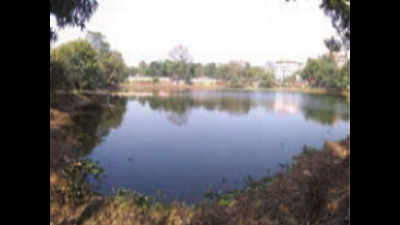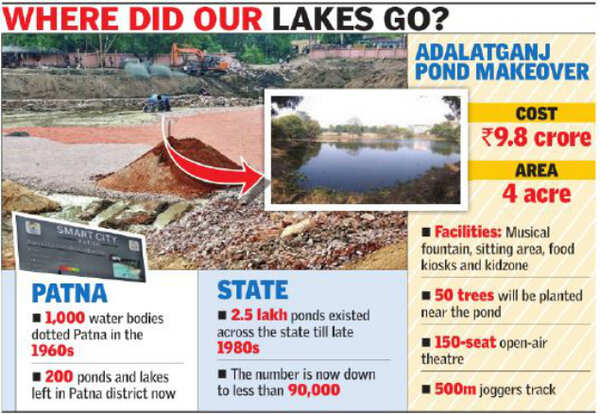- News
- City News
- patna News
- How Patna lost its water bodies
Trending
This story is from July 2, 2019
How Patna lost its water bodies
Gone are the days when Patna, which is surrounded by rivers from three sides, used to boast of its water resources. Disappearance of ponds and other water bodies from the state capital and other towns over the last few decades has become a cause for concern as far as availability of water is concerned

Disappearance of ponds and other water bodies from the state capital and other towns over the last few decades
PATNA: Gone are the days when Patna, which is surrounded by rivers from three sides, used to boast of its water resources. Disappearance of ponds and other water bodies from the state capital and other towns over the last few decades has become a cause for concern as far as availability of water is concerned.

For instance, the AIIMS-Patna building was constructed after filling of lakes spread over an area of 35 acres.Similarly, Indira Gandhi Science Complex or Patna Planetarium and Vaishali Cinema below Rajendra Nagar overbridge also came up after filling of water bodies. Several other ponds simply dried up, including the one behind old secretariat.
According to environmentalists, around 70% water bodies and wetlands in the state have vanished. “There were more than 2.50 lakh ponds in the state till late 1980s. However, the number has come down to less than 90,000 now,” said an environmentalist.
“About 70% water bodies have died in the state since 1980s either due to natural reasons or human interference. Kabar lake in Begusarai is a classic example of water bodies vanishing due to human interference. Encroachment by land mafias is to be blamed for this. The Kabar lake was one of south Asia’s largest freshwater lakes and a nesting ground for 59 species of migratory birds till 2001,” Ghosh added.
Meanwhile, the Patna Municipal Corporation (PMC) has initiated measures to revive two ponds in the city – Adalatganj Talab and Bahadurpur Talab. PMC commissioner Anupam Kumar Suman said the Adalatganj Talab would be revived under the Smart City scheme. “The pond will turn a recreational space for residents,” he said, adding work on revival of Adalatganj Talab has already begun and the deadline for its completion is March 2020.
The estimated cost of Adalaganj lake redevelopment project is Rs 9.8 crore. “The original water of the pond was drained out and the silt on the bed of the water body removed. The depth of the lake was increased by 10 feet,” the municipal commissioner said.
Suman said the periphery of the pond would be covered with plantation and stone- paved pathway. “The pond will be protected with railings and there will be a musical fountain as well. It will also have food kiosk, toilet, playing zone for kids, sitting kiosks, a television screen and car parking facility,” he said.
Suman added several other ponds in city, including Bahadurpur Talab, will also be revived in a similar manner. “Ward councillors have been asked to conduct surveys in their respective areas and identify ponds needing a makeover,” he said.
Satish Kumar, councillor of ward number 47, said there used to be two ponds in the locality. While one dried up, the other was encroached by land mafias. “The Bahadurpur Talab dried up two years ago and people started throwing garbage there. Boundary walls have been constructed to protect the plot,” he added.

For instance, the AIIMS-Patna building was constructed after filling of lakes spread over an area of 35 acres.Similarly, Indira Gandhi Science Complex or Patna Planetarium and Vaishali Cinema below Rajendra Nagar overbridge also came up after filling of water bodies. Several other ponds simply dried up, including the one behind old secretariat.
According to environmentalists, around 70% water bodies and wetlands in the state have vanished. “There were more than 2.50 lakh ponds in the state till late 1980s. However, the number has come down to less than 90,000 now,” said an environmentalist.
Ashok Ghosh, chairman of Bihar State Pollution Control Board (BSPCB), said the northern parts of the state were once famous for water bodies. “We never imagined in our wildest dreams that there will be scarcity of water in north Bihar. But look at the situation now. Even Darbhanga is facing water crisis. As far as water bodies and wetlands are concerned, they were allowed to die an unnatural death,” he said.
“About 70% water bodies have died in the state since 1980s either due to natural reasons or human interference. Kabar lake in Begusarai is a classic example of water bodies vanishing due to human interference. Encroachment by land mafias is to be blamed for this. The Kabar lake was one of south Asia’s largest freshwater lakes and a nesting ground for 59 species of migratory birds till 2001,” Ghosh added.
Meanwhile, the Patna Municipal Corporation (PMC) has initiated measures to revive two ponds in the city – Adalatganj Talab and Bahadurpur Talab. PMC commissioner Anupam Kumar Suman said the Adalatganj Talab would be revived under the Smart City scheme. “The pond will turn a recreational space for residents,” he said, adding work on revival of Adalatganj Talab has already begun and the deadline for its completion is March 2020.
The estimated cost of Adalaganj lake redevelopment project is Rs 9.8 crore. “The original water of the pond was drained out and the silt on the bed of the water body removed. The depth of the lake was increased by 10 feet,” the municipal commissioner said.
Suman said the periphery of the pond would be covered with plantation and stone- paved pathway. “The pond will be protected with railings and there will be a musical fountain as well. It will also have food kiosk, toilet, playing zone for kids, sitting kiosks, a television screen and car parking facility,” he said.
Suman added several other ponds in city, including Bahadurpur Talab, will also be revived in a similar manner. “Ward councillors have been asked to conduct surveys in their respective areas and identify ponds needing a makeover,” he said.
Satish Kumar, councillor of ward number 47, said there used to be two ponds in the locality. While one dried up, the other was encroached by land mafias. “The Bahadurpur Talab dried up two years ago and people started throwing garbage there. Boundary walls have been constructed to protect the plot,” he added.
End of Article
FOLLOW US ON SOCIAL MEDIA










